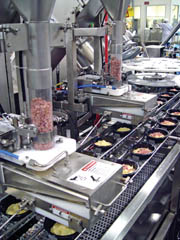
Founded in 1989, Request is a spinoff from Bil-Mar Foods, a western Michigan maker of ready-to-eat meats and frozen poultry products.
Today, Request copacks $140 million worth of frozen meals for major retailers and food manufacturers in its Holland, MI, facility. The 400-employee company has built four additions in the last 14 years, pushing total square footage to 360,000.
To deliver finished goods with taste appeal, Request prepares meal components separately and flash freezes them after assembly to ensure fresh taste. To deliver items with eye appeal, workers often fill bowls and other containers by hand, a costly and labor-intensive process, particularly with individual meal portions.
Request has six kitchens and six lines, producing such items as rice and pasta cups, lasagna casseroles and institutional meals and club packs. Individual servings are the fastest growing segment of the frozen-meal market, and portions measured in ounces meant escalating costs for Request. When a large order for a 12-oz. pasta dish was received two years ago, management saw an opportunity to automate. "Line automation included a flighted conveyor, denester and other equipment, including a filler," recalls Ray Huizenga, manager of plant operations. Higher fill speeds and greater accuracy were desirable benefits, but gentle handling also was critical. That consideration swayed the selection of a multi-purpose MPFSH-075 filler from Multi-Fill Inc.
A screw conveyor or pump would damage the short-cut pastas and other delicate ingredients filled at the plant, Huizenga points out. The Multi-Fill equipment relies on vacuum to pull ingredients into a volumetric pocket prior to dispensing. Vacuum also helps evacuate air and some moisture, increasing the density of the portion. Density correlates with fill accuracy, points out Merle DeWitt, director of operations. The fillers usually come within 1.5 percent of the targeted fill weight, he says, "while a person filling by hand might be within 4 or 5 percent."
Multi-Fill's Bill Allred says the MPFSH-075 volumetric filling system at Request is a standard machine for difficult-to-fill products. The translucent in-feed tube has an electronic level control, and the electronic eye that detects the target container precisely synchronizes with the dispensing unit. A number of optional components can be integrated, such as a needle assembly for ravioli and other filled pastas.
A second MPFSH-075 joined the first filler after six months, each with a fill rate of up to 75 containers per minute. Combined output is comparable to three workers. Multi-Fill engineers modified the in-feed belts' programming to reduce manual input, though an operator still is needed to service them. Consequently, the net manpower savings is two operators.
"We could easily put these fillers on three different lines," says Huizenga. "The units are cantilevered, which makes moving them around the plant simple."
Flexibility is a must in food manufacture, more so for copackers such as Request. As the company continues to adapt to growing demand and shifting market trends, investments like the MPFSH-075 fillers figure to be valuable assets for years to come.
For more information:
Bill Allred, Multi-Fill Inc.,
801-280-1570,
sales@multi-fill.com